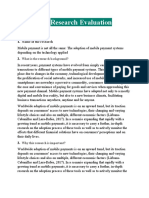Can you summarize your thesis and its main findings?
The thesis investigates the factors influencing the adoption of Point of Sale (POS)
systems among Small and Medium Enterprises (SMEs) in Butuan City. The research
identifies internal factors like customer motivation and perceived trust as significant
drivers of POS adoption. It highlights that aligning POS functionalities with consumer
needs enhances customer satisfaction and loyalty, thus encouraging SMEs to adopt
such technologies. Conversely, external factors like POS security and infrastructure
availability were found to be less influential. The study underscores the necessity
for SMEs to build trust in POS technologies and tailor their offerings to meet
customer expectations.
What specific challenges did you face while conducting this research, and
how did you address them?
Several challenges were encountered during the research process, including limited
access to respondents due to busy schedules, concerns about data reliability from
participants, and varying levels of technological understanding among SMEs. To
overcome these challenges, we utilized a convenience sampling method to gather
data from respondents who were available and willing to participate. Additionally,
we pilot-tested the questionnaire to ensure clarity and relevance, which helped
minimize misunderstandings and enhance data quality.
What motivated you and your team to choose this topic for your thesis?
The motivation for choosing the topic of "Factors Influencing the Adoption of POS
Systems Among SMEs in Butuan City" stemmed from the increasing reliance on
technology in business operations and the observed challenges faced by local SMEs.
With the potential benefits of POS systems in enhancing efficiency and customer
satisfaction, understanding the barriers and motivators behind their adoption was
deemed crucial. This research aligns with local economic development goals and
reflects our academic interests in management accounting and technology
integration.
Why did you choose a correlational research design for your study?
A correlational research design was chosen to explore the relationships between
multiple independent variables (such as perceived trust, customer motivation, and
external factors) and the dependent variable of POS adoption. This design was
deemed suitable as it allows the identification of significant associations without
manipulating variables, providing insights into how these factors interact in a
natural business setting.
�Can you explain your sampling technique and why it was appropriate for
your research?
The sampling technique employed was convenience sampling, which involves
selecting participants based on their availability and willingness to engage in the
study. This approach was appropriate given the limited pool of SMEs in Butuan City
and the necessity for quick data collection. It enabled us to gather relevant data
efficiently while ensuring that we could analyze the factors affecting POS system
adoption among the available SMEs.
How did you ensure that your survey questionnaire was valid and reliable?
To ensure the validity and reliability of the survey questionnaire, we conducted pilot
testing with a select group of SMEs. This involved gathering feedback from
participants to refine the questions for clarity and relevance. Additionally, we sought
expert opinions from faculty and industry professionals to assess the content
validity of the questionnaire. Reliability was evaluated using Cronbach’s alpha,
achieving an acceptable level which indicated consistent responses among
participants.
What were the most significant factors influencing the adoption of POS
systems according to your findings?
The most significant factors influencing the adoption of POS systems identified in
the study were internal factors, particularly perceived trust and customer
motivation. Participants expressed a strong belief that trustworthy technology and
alignment with customer preferences significantly impacted their decisions to adopt
POS systems. External factors like infrastructure availability and POS security were
less influential in motivating adoption.
How did you determine the correlation between internal factors such as
perceived trust and customer motivation with POS adoption?
The correlation between internal factors, including perceived trust and customer
motivation, and POS adoption was determined using statistical analysis methods,
particularly the Spearman’s rank correlation coefficient. This non-parametric
measure allowed us to assess the strength and direction of relationships between
these variables, indicating that as perceived trust and customer motivation
increased, so did the likelihood of adopting POS systems.
Can you elaborate on the statistical methods used to analyze your data?
The data analysis involved descriptive statistics to summarize respondents' answers
and inferential statistics to explore relationships between variables. Specifically,
�Spearman’s correlation was utilized to measure the correlations between internal
and external factors influencing POS adoption. The analysis was conducted using
software tools like SPSS, which facilitated the statistical evaluations and visual
representations of the data.
What implications do your findings have for SMEs in Butuan City regarding
technology adoption?
The findings imply that SMEs in Butuan City should prioritize internal motivations,
such as building trust with their customers and aligning technology with consumer
needs. Enhancing customer experience through tailored POS functionalities can lead
to improved customer satisfaction and loyalty, thereby increasing the likelihood of
adopting POS systems. Overall, fostering a positive perception of POS technologies
is crucial for operational growth.
How can your research inform policymakers in improving the business
environment for SMEs?
This research can inform policymakers by highlighting the critical factors that
encourage technology adoption among SMEs, such as trust and customer-centric
approaches. Policymakers can develop support programs that facilitate training in
technology usage, improve infrastructure availability, and address security
concerns. By creating a favorable environment for technology adoption,
policymakers can stimulate economic growth and enhance the operational
capabilities of SMEs in Butuan City.
In what ways do you think enhancing customer experience impacts the
adoption of POS systems?
Enhancing customer experience is directly related to the adoption of POS systems,
as consumers increasingly expect efficient and personalized service. A robust POS
system can streamline transactions, reduce wait times, and provide accurate, real-
time data. This improved interaction not only boosts customer satisfaction but also
fosters customer loyalty, motivating businesses to adopt technologies that enhance
these experiences. Businesses that meet or exceed customer expectations are more
likely to succeed in a competitive market.
What areas for further research did you identify based on your findings?
�Future research could focus on longitudinal studies to track changes in POS
adoption trends over time, or comparative studies across different sectors or
regions to identify varying factors influencing adoption. Additionally, exploring the
roles of training and support in the adoption process could provide deeper insights.
Investigating technological advancements in POS systems, such as AI integration
and their impacts on business performance, is also an avenue for future inquiry.
If you were to extend your study to another locale or sector, what changes
would you consider making?
If extending the study to another locale or sector, I would broaden the sample size
to include a more diverse range of SMEs and potentially incorporate qualitative
research methods to gather richer insights. Additionally, examining different
sectors, such as healthcare or hospitality, would provide valuable comparisons in
technology adoption dynamics. A longitudinal design could also be considered to
capture changes in attitudes and behaviors over time.
How did this research challenge or change your understanding of
technology adoption in SMEs?
This research challenged my initial perception that technology adoption was
primarily driven by external factors like resources and infrastructure. The findings
emphasized that internal factors, particularly trust and customer motivation,
significantly influence the adoption process. Understanding the critical role of user
perception and customer-centric approaches reshaped my perspective on the
strategies SMEs should employ to successfully integrate technology.
What would you do differently if you were to repeat this study?
If I were to repeat this study, I would consider using a mixed-methods approach,
incorporating both qualitative and quantitative data to enhance richness and depth.
I would increase the sample size for more representative findings and implement
longitudinal tracking of POS adoption trends. Furthermore, I would explore the
impact of training and support on successful implementation, ensuring that
businesses have the resources needed for effective technology use.




















































































































